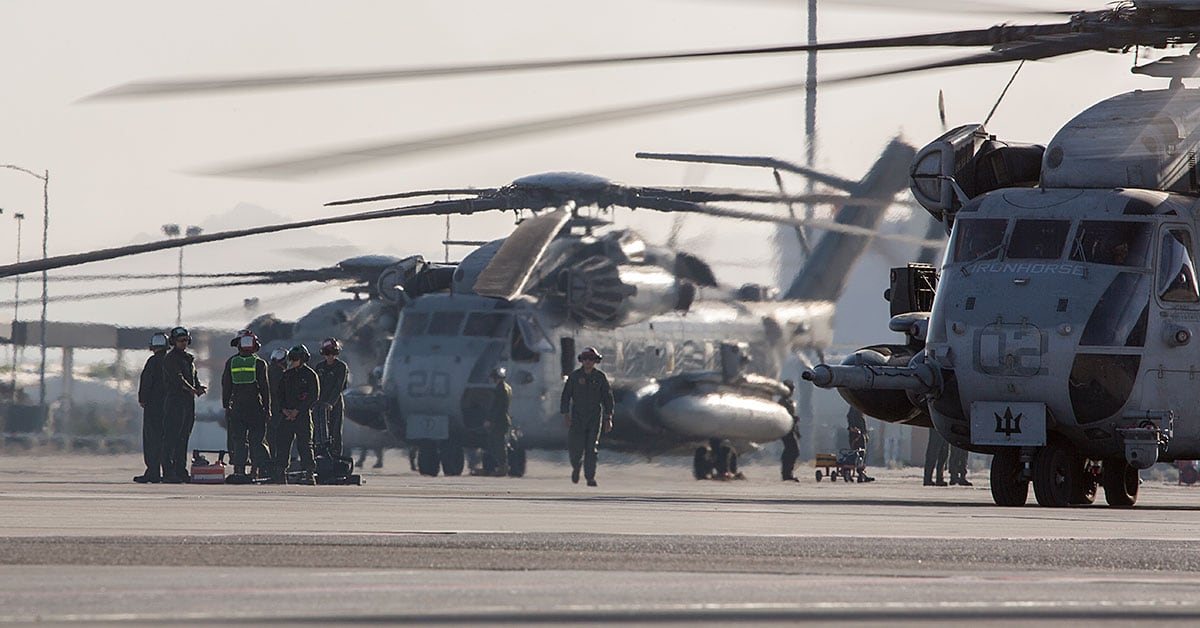The military services saw an overall decline in the total number of serious aviation mishaps and aviation-related fatalities in 2019, reversing a trend in recent years that saw record-high numbers of serious aviation mishaps and deaths in recent years.
Across the force, the total number of major mishaps — defined as those categorized as Class A though Class C, depending on the extent of damage or injury the individual mishaps caused — dropped slightly last year. The Pentagon reported 1,005 major mishaps in 2019, down from 1,036 in 2018, according to a Military Times analysis of Defense Department data.
Specifically, for the individual services, the mishap data showed:
• The Air Force saw a 7 percent drop in overall mishaps.
• The Navy’s numbers for Class A though Class C mishaps plummeted 20 percent.
• The Army reported a more than 30 percent decline.
• The Marine Corps was the only service to see a spike in the number total number of Class A through Class C mishaps, as the total rose to 30 percent.
The latest information comes as the Pentagon and top military leaders continue to prioritize the need to reduce the rate of serious aviation mishaps and crashes involving aircraft across the force.
For aviation fatalities, the Pentagon reported a sharp decline across the services in 2019. Last year, a total of 13 service members died in mishaps, compared with the previous year’s 39 ― which had marked a 10-year high.
The Marine Corps suffered the worst streak of fatalities, reporting eight Marines who died in aircraft accidents, including a late 2018 aerial refueling collision that killed six aircrew between the tanker and fighter jet involved.
Despite the broad decline in mishaps, trouble spots remain: the latest data shows that three of the four services reported a rise in the most dangerous type of crashes, the Class A mishaps ― defined as those that involve death or permanent disability, and/or more than $2.5 million in damage.
Among the Class A mishaps, the Corps reported an increase from six in fiscal year 2018 to eight in fiscal year 2019, including a late 2018 aerial refueling collision that killed six aircrew between the tanker and fighter jet involved. The Defense Department’s fiscal year starts on Oct. 1.
Representatives of the services safety centers, when contacted by Military Times, stressed that each service is committed to training their forces and investigating mishaps, but didn’t offer any insights on why they believed their numbers had gone up or down.
Several factors are at play when it comes to mishap rates. Aircraft maintenance errors are often cited in safety investigation reports as the cause of a mishap, as is pilot or aircrew error ― which can be caused by anything from a lack of sleep to a mistake while flying in inclement weather.
Another is flight hours, which can affect the frequency of serious incidents in both directions. While more flight hours can mean more opportunities for mishaps, reductions in flight hours come at the cost of the experience and repetition so vital to keeping pilots and crew at the top of their game, creating a dangerous mix when they do get in the air.
For example, according to the investigation into the December 2018 crash involving a Marine Corps KC-130J refueler and F/A-18 Hornet, the pilot was unqualified for the nighttime refueling exercise, with only 13 of required 60 flight hours to qualify under his belt.
But overall, flight hours did not fluctuate enough to explain the differences in mishap rates between 2018 and 2019, as the Navy and Marine Corps’ total flight hours dropped by about 3,000 for each service. In the Army, flight hours jumped by more than 30,000 in 2019, while they declined by the same number in the Air Force ― despite an increase in Class As for the Army and an overall drop in mishaps for the Air Force.
Following the 2018 reporting by Military Times about record-high mishap rates, the congressional armed services committees held hearings and demanded answers from Pentagon officials.
At the time, aviation mishaps had spiked by 40 percent in the previous five years. A record 133 service members died in aviation accidents during that period. Experts placed the blame on the budget cuts known as “sequestration” that began in 2013. Those budget cuts forced the aviation community to significantly cut back on training hours and also led to an exodus of many of the most experienced maintainers in the senior noncommissioned officer corps.
By late 2018, the House Armed Services Committee announced it would form an independent commission of eight aviation experts from military and industry backgrounds, to survey aviation units across the military and report back their findings.
Two years later, progress has been made, but preventable deaths and dozens of destroyed aircraft a year ― at tens of millions of dollars each ― still plague the services.
Air Force mishaps
The Air Force had 667 total major incidents in 2019, down from 716 total in 2018, a reduction of about 7 percent.
The service saw the most progress in fatalities, however, dropping from 17 in 2018 to two in 2019, while overall Class A mishaps dropped from 30 to 22.
“When the numbers go down the next year, you’re not going to necessarily take a victory lap,” Maj. Gen. John Rauch, head of the Air Force Safety Center, told Air Force Times in February. “If they return more towards normal, or even a little below normal, you’re gonna say, ‘We need to continue doing those proactive things.’ It’s not like one year is going to wash that away.”
For the Air Force, which by its nature has the most aviation mishaps of any of the services, incidents related to ground operations and those that happen in flight are mostly evenly distributed.
However, the Air Force has seen an uptick in Class A mishaps within its fighter and attack communities. Fighters saw the most increases in mishaps, with the F-15, F-16, F-22 and F-35 communities spiking from 190 incidents in 2018 to 243 in 2019.
Navy
The Navy, home to military aviation’s second largest community, saw more than a 20 percent drop in its overall serious aviation incidents from 2018 to 2019. The service almost halved its Class As, down to 8 in 2019.
The service’s total flight hours dropped by about 3,000 year over year, showing not only a reduction in incidents but an improvement in the mishap rate, as well.
“At this time, it is difficult to definitively identify the specific actions or combination of actions that have resulted in a difference between the FY18 and FY19 aviation mishaps,” according to Stephanie Slater, spokeswoman for the Naval Safety Center, which overseas Marine Corps aviation. “The Navy and Marine Corps continually evaluate their programs, looking at lessons learned and best practices from a safety perspective to help ensure we maintain and preserve our war fighting capability.”
Navy aviation’s one fatality came late last July, when a Naval Air Station Lemoore, California-based F/A-18E Super Hornet crashed during a training flight over Death Valley, injuring seven tourists and killing its pilot, 33-year-old Lt. Charles Walker.
Marine Corps
While the other services saw an overall reduction in serious mishaps, the Marine Corps’ numbers spiked in 2019, up to 97 from 74 the previous year.
Six of eight fatalities in FY19 came from the tanker-fighter crash in late 2018, four more aviation deaths than the service reported the previous year.
“As the service’s safety advocate, the Naval Safety Center remains committed to identifying hazards and reducing risks to our people and resources,” Slater said. “We will continue to provide advanced data analytics as well as in-depth studies, trends and sophisticated modeling data that can be used to help prevent mishaps.”
Throughout naval aviation, which includes both Navy Department services, fighters had by far the most mishaps, clocking in at 97 incidents for F/A-18s and F-35s, or about 35 percent of A, B and C mishaps. Five of those were Class A accidents.
Army
Like the Air Force and Navy, the Army reduced overall mishaps, down from 85 in 2018 to 65 in 2019. But its Class As did rise, with 12 in 2019, versus 11 in 2018.
“While the Army has seen a relatively steady drop in aviation accident rates over the past decade, anytime the Army encounters an aviation accident, we carefully consider the potential for accident trends and quickly institute measures to mitigate contributing factors,” Army spokesman Jason Waggoner told Military Times.
As in past years, the UH-60 Black Hawk continued to be the deadliest ― as well as the most numerous ― Army airframe with 17 mishaps, two of which were Class As resulting in a death on board.
One of them was a medevac flight at Fort Pork, Louisiana, to recover a soldier with heat stroke out on a range. The crash killed the pilot, Maj. Trevor Joseph, but three more aircrew on board survived.
Aviation safety commission
As all four of the services have touted their efforts to improve their aviation communities’ maintenance capacity and safety culture, the National Commission on Military Aviation Safety opened up a system on its website last year, for service members to report safety concerns in their units.
“I have a fixed opinion that the difference between a Class C and a Class A is inches and luck,” NCMAS chairman retired Army Gen. Dick Cody, a former vice chief of staff, career helicopter pilot and aviation maintenance officer, told reporters in last fall. “We’ve got the attitude that the absence of an accident doesn’t mean the presence of safety. I think we’re going to learn as much from the Cs and the As.”
The commission’s report, originally due in March, has been pushed back to December.
Meghann Myers is the Pentagon bureau chief at Military Times. She covers operations, policy, personnel, leadership and other issues affecting service members.





